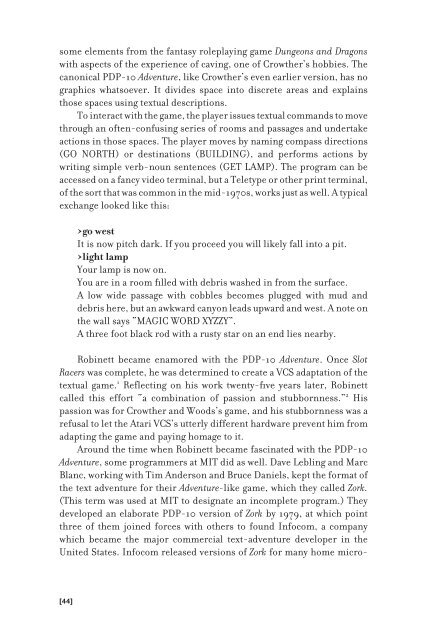Racing the Beam : the Atari Video Computer System - Index of
Racing the Beam : the Atari Video Computer System - Index of
Racing the Beam : the Atari Video Computer System - Index of
You also want an ePaper? Increase the reach of your titles
YUMPU automatically turns print PDFs into web optimized ePapers that Google loves.
some elements from <strong>the</strong> fantasy roleplaying game Dungeons and Dragons<br />
with aspects <strong>of</strong> <strong>the</strong> experience <strong>of</strong> caving, one <strong>of</strong> Crow<strong>the</strong>r’s hobbies. The<br />
canonical PDP-10 Adventure, like Crow<strong>the</strong>r’s even earlier version, has no<br />
graphics whatsoever. It divides space into discrete areas and explains<br />
those spaces using textual descriptions.<br />
To interact with <strong>the</strong> game, <strong>the</strong> player issues textual commands to move<br />
through an <strong>of</strong>ten-confusing series <strong>of</strong> rooms and passages and undertake<br />
actions in those spaces. The player moves by naming compass directions<br />
(GO NORTH) or destinations (BUILDING), and performs actions by<br />
writing simple verb-noun sentences (GET LAMP). The program can be<br />
accessed on a fancy video terminal, but a Teletype or o<strong>the</strong>r print terminal,<br />
<strong>of</strong> <strong>the</strong> sort that was common in <strong>the</strong> mid-1970s, works just as well. A typical<br />
exchange looked like this:<br />
[44]<br />
>go west<br />
It is now pitch dark. If you proceed you will likely fall into a pit.<br />
>light lamp<br />
Your lamp is now on.<br />
You are in a room fi lled with debris washed in from <strong>the</strong> surface.<br />
A low wide passage with cobbles becomes plugged with mud and<br />
debris here, but an awkward canyon leads upward and west. A note on<br />
<strong>the</strong> wall says “MAGIC WORD XYZZY”.<br />
A three foot black rod with a rusty star on an end lies nearby.<br />
Robinett became enamored with <strong>the</strong> PDP-10 Adventure. Once Slot<br />
Racers was complete, he was determined to create a VCS adaptation <strong>of</strong> <strong>the</strong><br />
textual game. 1 Refl ecting on his work twenty-fi ve years later, Robinett<br />
called this effort “a combination <strong>of</strong> passion and stubbornness.” 2 His<br />
passion was for Crow<strong>the</strong>r and Woods’s game, and his stubbornness was a<br />
refusal to let <strong>the</strong> <strong>Atari</strong> VCS’s utterly different hardware prevent him from<br />
adapting <strong>the</strong> game and paying homage to it.<br />
Around <strong>the</strong> time when Robinett became fascinated with <strong>the</strong> PDP-10<br />
Adventure, some programmers at MIT did as well. Dave Lebling and Marc<br />
Blanc, working with Tim Anderson and Bruce Daniels, kept <strong>the</strong> format <strong>of</strong><br />
<strong>the</strong> text adventure for <strong>the</strong>ir Adventure-like game, which <strong>the</strong>y called Zork.<br />
(This term was used at MIT to designate an incomplete program.) They<br />
developed an elaborate PDP-10 version <strong>of</strong> Zork by 1979, at which point<br />
three <strong>of</strong> <strong>the</strong>m joined forces with o<strong>the</strong>rs to found Infocom, a company<br />
which became <strong>the</strong> major commercial text-adventure developer in <strong>the</strong><br />
United States. Infocom released versions <strong>of</strong> Zork for many home micro-


